Adult social care monthly statistics, England: May 2021
Updated 17 May 2021
Applies to England
Main points
Vaccination in social care settings
As of 27 April 2021, the proportions who had received the first dose of the COVID-19 vaccine were:
-
94.6% of residents and 81.0% of staff of older adult care homes
-
89.8% of residents of younger adult care homes
-
77.5% of staff of younger adult care homes, 72.8% of domiciliary care staff and 70.7% of staff employed in other social care settings
Infection control measures in care homes
In the week ending 26 April 2021:
-
82.5% of care homes in England were able to accommodate residents receiving visitors within care homes, compared to 40.3% at the beginning of March 2021
-
83.6% of care homes who had staff required to self-isolate paid those staff their full wages while self-isolating. This proportion has remained consistent since mid-December
-
78.2% of care homes had no staff members working in another health or social care setting, this proportion has remained largely consistent since mid-December
COVID-19 testing in care homes
ln the week ending 27 April 2021:
-
there were 480,530 polymerase chain reaction (PCR) tests and 505,822 lateral flow device (LFD) tests taken by care home staff. There were 319 positive results returned from PCR tests and 411 returned from LFD tests, this has substantially decreased for both kits compared to mid-January
-
there were 78,417 PCR tests and 7,905 LFD tests taken by care home residents. There were 121 positive results returned from PCR tests and 14 returned from LFD tests. This has substantially decreased for both kits compared to mid-January
Introduction
This is the first monthly publication by the Department of Health and Social Care (DHSC) of statistics on adult social care in England. This statistical bulletin provides an overview on a range of information on social care settings, with a focus on the impact of COVID-19.
This report provides newly published information on:
-
selected infection prevention control (IPC) measures in care homes at national, regional and local authority (LA) level
-
staffing levels in care homes at national, regional and LA level
-
testing for COVID-19 in care homes at national, regional and LA level
This report also includes previously published statistics on first dose uptake of COVID-19 vaccinations in adult social care settings.
For more information and links to other published sources of adult social care data please see the About this data section below.
Terminology
Older adult care homes: care homes serving any older people (aged 65 and over) as identified from the latest Care Quality Commission (CQC) data on care homes in the ‘older people service’ user band. A small number of residents within care homes serving older people may be aged under 65.
Younger adult care homes: care homes not serving any older people (aged 65 and over) as identified from the latest CQC data on care homes in the ‘older people service’ user band.
Domiciliary care: services providing personal care for people living in their own homes. The data in this bulletin refers to domiciliary staff employed by independent CQC registered providers.
Staff: in this publication staff can refer to staff directly employed by a provider or through an agency.
Staff employed by other settings: this includes non-registered providers and local authority employed: all other eligible frontline social care staff working in close and personal contact with people clinically vulnerable to COVID-19 (as defined by the Joint Committee on Vaccination and Immunisation (JCVI) priority groups) who need care and support irrespective of where they work or who they are employed by, for example, local government, NHS, private sector or third sector.
Agreed staffing ratios: the agreed number of residents for any given member of staff. This is determined by individual providers to ensure there is safe levels of staffing for care to be delivered. This can be subject to inspection by the CQC. See Regulation of staffing for more information.
PCR (polymerase chain reaction) tests: PCR tests check for the genetic material of the coronavirus in the sample, which is taken using a swab and is processed in a lab via a polymerase chain reaction (PCR). These are predominantly used in care homes for people who experience symptoms, and for routine asymptomatic testing for staff and residents.
LFD (lateral flow device): often referred to as ‘rapid tests’, these test for the presence of proteins called ‘antigens’ which are produced by the virus. They are swab tests that give results in 30 minutes or less, without the need for processing in a laboratory. These tests are primarily used in care homes for routine asymptomatic testing for staff, residents and visitors.
COVID-19 vaccination in adult social care settings
The NHS started administering vaccinations for COVID-19 in England on 8 December 2020. Social care staff and residents of care homes were prioritised for the vaccine according to the Joint Committee on Vaccination and Immunisation (JCVI) recommendation. For more information see guidance on priority groups for coronavirus (COVID-19) vaccination: advice from the JCVI.
Adult social care groups covered in this publication by JCVI priority group
This is a summary of the priority groups for different social care staff and residents.
JCVI priority group 1
-
residents in older adult care homes
-
staff directly employed by older adult care homes
-
agency staff working in older adult care homes
JCVI priority group 2
-
staff directly employed by younger adult care homes
-
agency staff working in younger adult care homes
-
domiciliary care staff registered to independent CQC providers
-
social care staff working in other settings (including non-registered providers and local authority employed)
Not in a specific JCVI priority group
- residents of younger adult care homes
This bulletin presents the proportion of staff and residents vaccinated out of the total number of staff and residents as self-reported by care providers. Only individuals who have not tested positive for COVID-19 in the last 28 days are eligible to receive the vaccine. Data on the number of staff and residents of older adult care homes eligible for the vaccination over time can be found in the accompanying COVID-19 vaccination tables.
NHS England also publish data on vaccinations in adult social care settings as part of their broader statistical release on COVID-19 vaccination. More details on the data collection, coverage and quality of this data can be found in the About this data section below.
First dose of COVID-19 vaccinations in JCVI priority group 1
94.6% of residents and 81.0% of older adult care home staff have received their first COVID-19 vaccine dose as of 27 April 2021. The proportion rapidly increased between January and February 2021 and has since continued to increase but at a slower pace as more of the population receive the vaccine.
First dose vaccination rates are similar across all regions for residents in older adult care homes. There is substantial variation across regions for staff in older adult care home staff with 72.0% in London having received the first dose compared to 86.6% in the North East.
Figure 1: cumulative proportion of JCVI priority group 1 staff and residents who have received the first dose, England
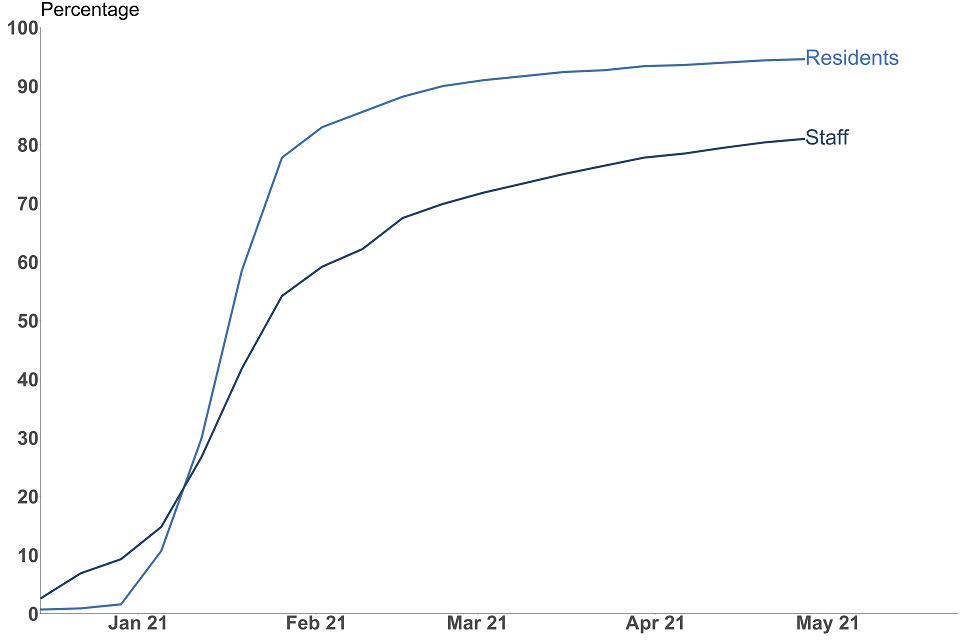
This data can be found in Tables 1 and 2 of the accompanying ‘COVID-vaccination’ tables in addition to data by region and local authority.
First dose of COVID-19 vaccinations in JCVI priority group 2
77.5% of staff of younger adult care homes have received their first COVID-19 vaccine dose as of 27 April 2021. The proportion rapidly increased between January and March 2021 and has since continued to increase but at a slower pace as more of the population receive the vaccine.
72.8% of domiciliary care staff and 70.7% of staff working in other settings have received their first COVID-19 vaccine dose as of 27 April 2021.
Figure 2: cumulative proportion of JCVI priority group 2 staff who have received the first dose, England
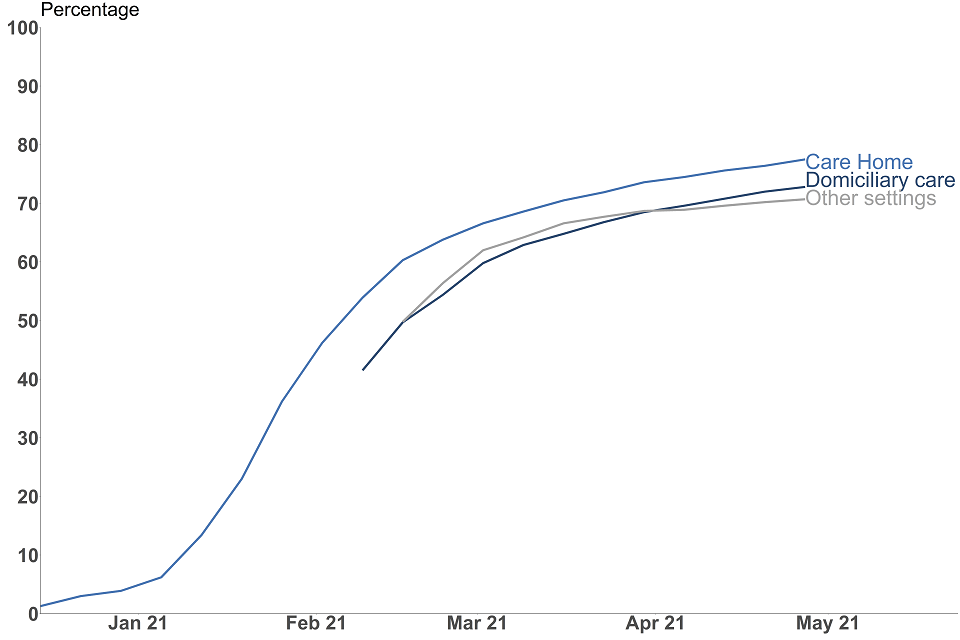
This data can be found in Tables 3 to 5 of the accompanying ‘COVID-vaccination’ tables in addition to data by region and local authority.
There is notable regional variation for all staff groups in priority group 2.
Table 1: percentage of staff in JCVI priority group 2 who have received the first dose by region up to 27 April 2021, England
| Region | Staff of younger adult care homes | Domiciliary care staff | Staff employed in other social care settings |
|---|---|---|---|
| East Midlands | 74.0 | 74.7 | 74.8 |
| East of England | 78.3 | 75.1 | 73.7 |
| London | 71.0 | 55.6 | 56.5 |
| North East | 87.7 | 84.2 | 86.8 |
| North West | 74.8 | 73.8 | 68.4 |
| South East | 77.7 | 75.6 | 64.4 |
| South West | 80.1 | 78.3 | 84.1 |
| West Midlands | 75.7 | 71.7 | 66.2 |
| Yorkshire and the Humber | 81.3 | 77.0 | 71.5 |
First dose of COVID-19 vaccinations for residents of younger adult care homes
Residents of younger adult care homes are not part of a single priority group. However, the conditions for which they reside in care homes are likely to make them more vulnerable to COVID-19 and they are therefore likely to be part of priority groups 3 to 9.
As of 27 April 2021, 89.8% of residents in younger care homes have received their first COVID-19 vaccine dose.
Infection prevention control measures
The Adult Social Care Infection Control Fund provides funding from local authorities to ensure that infection prevention control (IPC) measures are in place to curb the spread of COVID-19. This publication provides data on how providers are implementing the following measures:
-
limitation of staff movement across different social care settings
-
accommodating COVID-19 safe visitation in care homes
-
payment of full wages when care home staff are isolating due to COVID-19
Data for each reporting week refers to data up to 2pm on the date stated as the ‘week ending’ and the 7 days prior. The reporting week usually ends on a Tuesday but occasionally no data is available for this date. In these situations the ‘week ending’ date will be the nearest available date.
More details on the data collection, coverage and quality of this data can be found in the About this data section below.
Accommodating COVID-safe visitation in care homes
The guidance on allowing care home residents to have visitors has changed since December 2020 which is summarised in the table below.
Table 2: visiting guidance since December 2020
| Date | Guidance |
|---|---|
| 12 April 2021 to present | Residents are permitted to have 2 named visitors for regular visits with testing in place |
| 8 March to 11 April 2021 | Residents are permitted to have 1 named visitor for indoor visits with testing in place |
| 6 January to 7 March 2021 | No indoor visits permitted due to the national lockdown |
| 1 January 2020 to 5 January 2021 | Indoor visits permitted with testing in place (from 19 December 2020 – no indoor visits permitted in Tier 4 areas) |
More information can be found in the guidance on care home visiting.
In the week ending 26 April 2021, 82.5% of care homes in England were able to accommodate residents receiving visitors within care homes in all circumstances compared to 40.3% in the week ending 2 March 2021.
The number of providers accommodating visiting in all circumstances has been gradually increasing since early March in line with visitation guidance introduced on 8 March 2021 which allows residents to have designated regular visitors. A further 6.6% were able to accommodate visits in exceptional circumstances in the week ending 26 April 2021. Exceptional circumstances are individually defined by each care home but are generally thought to be considered when residents are palliative.
Between late December and early January 2021, the proportion of care homes accommodating visiting steadily declined in line with the change in guidance introduced, as well as the national lockdown.
There is substantial regional variation with 86.1% of care homes accommodating visitors in the North West in comparison to 70.0% in London in the week ending 26 April 2021.
Figure 3: proportion of care homes accommodating or limiting visits for residents, England
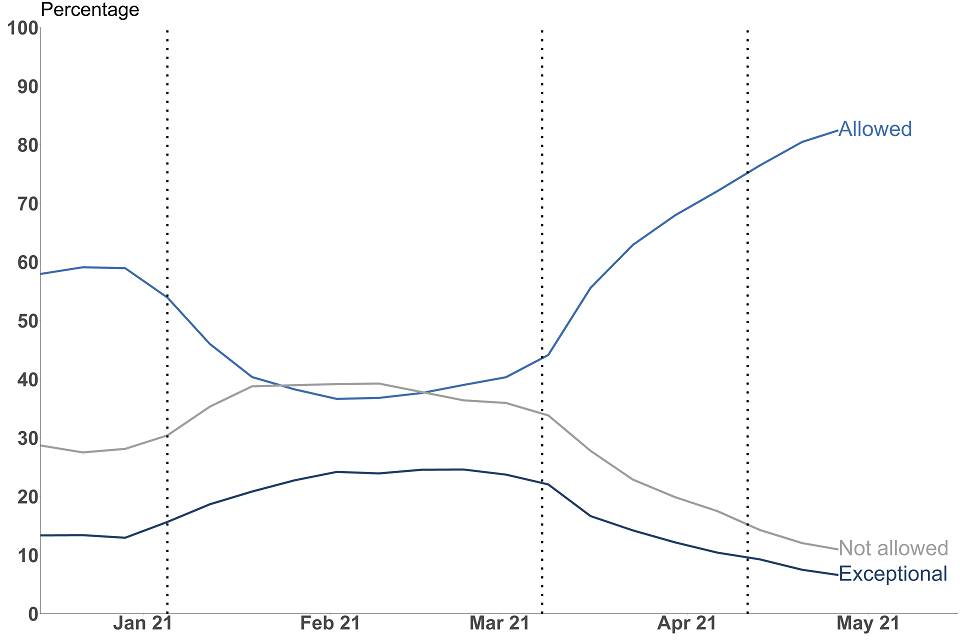
This data can be found in Table 1 of the accompanying ‘Infection control’ tables in addition to data by region and local authority.
Payment of care home staff whilst self-isolating due to COVID-19
The infection control funds can be used to ensure staff who are self-isolating along with government guidance are paid their full wages. This includes:
-
staff isolating while waiting for a test
-
isolating after having tested positive or after a positive test in their household
-
staff required to quarantine prior to receiving certain NHS procedures
For more information see stay at home: guidance for households with possible or confirmed coronavirus (COVID-19) infection.
Employers who do not pay their staff their full wages whilst self-isolating must pay their staff at least Statutory Sick Pay (SSP) when the employee meets the following criteria:
-
is classed as an employee and has done some work for their employer
-
earns an average of at least £120 per week
-
has been ill or is self-isolating for at least 4 days in a row (including non-working days)
Care home staff who do not meet the criteria may not be eligible and as a result not paid to self-isolate. For more information, please see guidance on Statutory Sick Pay.
In the week ending 26 April 2021, 83.6% of care homes who had staff needing to self-isolate paid staff their full wages. This proportion has remained consistent since mid-December.
There is notable regional variation with 89.9% of providers in the North East paying their staff full wages compared to 77.4% in the West Midlands in the week ending 26 April 2021.
Figure 4: proportion of care homes by wages paid to staff during self-isolation in the week ending 26 April 2021, England
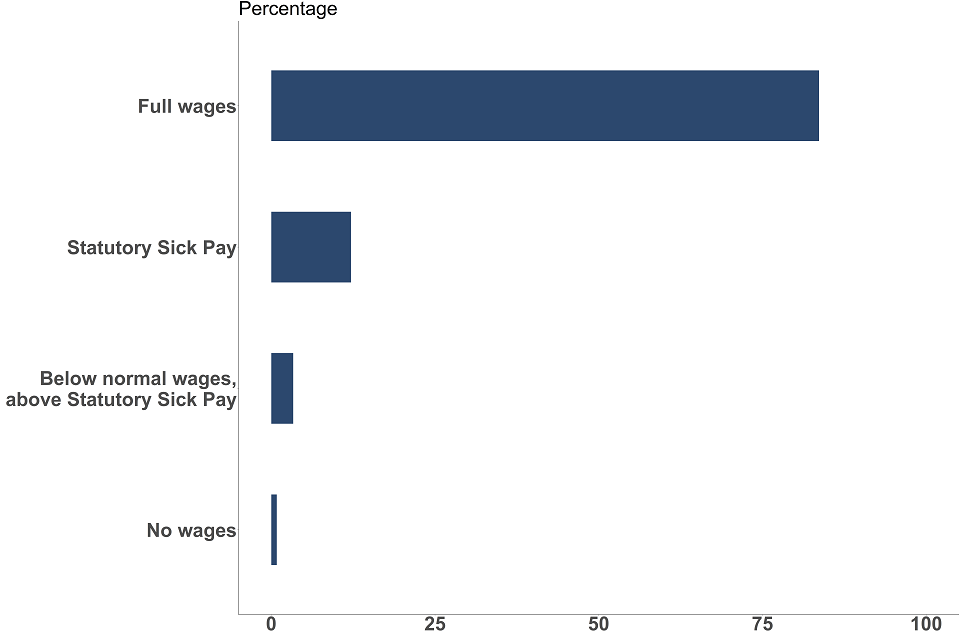
This data can be found in Table 2 of the accompanying ‘Infection control’ tables in addition to data by region and local authority.
Limiting staff movement between care settings
Infection control funding can be used to reduce the need for staff movement between social care settings to limit the spread of infection, for example they can be used to recruit additional staff to enable staff to only work across one care home.
In the week ending 26 April 2021, 78.2% of care homes had no staff members working in another social care setting; this proportion has remained largely consistent since mid-December 2020. 6.2% of care homes had some staff additionally working in another health or social care setting whilst a further 15.6% of care homes had some staff additionally working in another health or social care setting due to exceptional circumstances. Exceptional circumstances are defined as the care home having exhausted all other reasonable steps to ensure there are sufficient staffing levels.
Figure 5: proportion of care homes with no staff working in another health or social care setting in the week ending 26 April 2021, England

This data can be found in Table 3 of the accompanying ‘Infection control’ tables in addition to data by region and local authority.
There is notable regional variation with 85.9% of providers in the North West having no staff working in another health or social care setting in the week ending 26 April 2021, in comparison to 71.6% in London.
Adult social care staffing levels
To enable providers to meet workforce challenges, such as maintaining safe staffing-levels over the winter period, on 16 January 2021 the government announced an extra £120 million Workforce Capacity Fund to support local authorities to manage workforce pressures.
In order to measure the workforce pressures on providers during the pandemic, each provider is asked to assess their workforce pressures based on their agreed staffing ratios.
In the week beginning 26 April 2021, 0.2% of providers flagged that their agreed staffing ratios had been breached, 2.6% flagged that they were operating within the agreed staffing ratios but there is a significant risk of escalation in the coming days and 97.2% were operating within their agreed staffing ratios. This has remained consistent since mid-December 2020. If a care home’s staffing ratio has been breached, then business continuity measures may be put in place.
Figure 6: proportion of care homes where the agreed staffing ratios have been breached in the week ending 26 April 2021, England

This data can be found in Table 4 of the accompanying ‘Infection control’ tables in addition to data by region and local authority.
COVID-19 testing in adult care homes
The rollout of the testing programme in care homes is summarised below. See the terminology section above for more details on testing kits used.
Table 3: testing guidance in care homes
| Dates | Frequency | Test Kit | |
|---|---|---|---|
| Care home residents | 7 June 2020 to present | Monthly In the event of an outbreak: day 1 and between days 4 to 7 |
PCR |
| Care home residents | 22 February 2021 to present | In the event of an outbreak: day 1 and between days 4 to 7 at health protection team discretion | LFD |
| Care home staff | 7 June 2020 to present | Weekly In the event of an outbreak: day 1 and between days 4 to 7 |
PCR |
| Care home staff | 23 December 2020 to present | Twice a week In the event of a positive case: daily until 5 days without a positive | LFD |
| Care home indoor visitors | 8 March 2021 to present | Weekly – essential care givers | PCR |
| Care home indoor visitors | 8 March 2021 to present | Twice weekly – essential care givers | LFD |
| Care home indoor visitors | 2 December 2020 to present* | On visit | LFD |
| Care home visiting professionals – CQC inspectors | 14 December 2020 to present | Weekly | PCR |
| Care home visiting professionals – CQC inspectors | 22 December 2020 to present | Before visit | LFD |
| Care home visiting professionals – all other professionals | 14 December 2020 to present | On arrival, unless part of a regular testing regime and can provide proof of a negative result within 72 hours | LFD |
*Close contact visits with LFD testing began on 2 December 2020 but ceased on 6 January 2021 because of the national lockdown. Throughout the period of national restrictions, visits were limited to outdoors, in visiting pods, or with a substantial screen; as well as those in exceptional circumstances such as end of life.
If anyone tests positive with a PCR test, then they are exempt from regular testing for 90 days. For more information please see guidance on coronavirus (COVID-19) testing in adult care homes.
This report includes the number of tests conducted on care home residents, staff and visitors who were tested by:
-
PCR and LFD kits sent directly to the care home for regular testing, which were registered through the National Testing Programme digital infrastructure
-
PCR and LFD kits conducted at another testing site such as a regional or local test site or a mobile testing unit or tests that were registered
The figures in this report are only deduplicated to report on the number of individual tests taken, not the number of people tested. Because people can have more than one test, the data should not be compared with prevalence rates or case positivity rates.
This report does not contain data on those tested through pillar 1.
DHSC also publishes care home testing data in the weekly NHS Test and Trace statistics (England) at National level. This publication uses the same data source but has a different methodology for presenting testing in care homes. More details on the differences along with details on the data collection, coverage and quality can be found in the ‘About the data’ section of this report.
Number of PCR and LFD tests conducted in adult care homes
Care home staff
The number of PCR tests conducted among care home staff steeply increased from 257,113 tests in the week ending 8 September 2020 to 518,609 in the week ending 22 December 2020. A decrease in the number of tests was seen in the period between late December and early January due to the Christmas and New Year period. Between January 2021 and early April 2021, the number of PCR tests conducted gradually declined.
The number of LFD tests conducted among care home staff increased sharply from 46,019 tests in the week ending 29 December 2020[footnote 1], when LFD testing guidance was introduced, to 551,317 in the week ending 9 February 2021. Between early February 2021 and early April 2021, the number of LFD tests conducted then gradually declined.
Since early April 2021 the number of LFD and PCR tests conducted have both begun to increase again, with 505,822 and 480,530 tests respectively in the week ending 27 April 2021.
Given that anyone who tests positive with a PCR test is exempt from regular testing for 90 days, the number of tests conducted with both PCR and LFD kits can fluctuate slightly in relation to COVID-19 prevalence.
Care home residents
The number of PCR tests conducted among care home residents increased from 76,134 tests in the week ending 8 September 2020 to 100,447 in the week ending 10 November 2020. This has since begun to decline with 78,417 tests conducted in the week ending 27 April 2021.
The number of LFD tests conducted among care home residents gradually increased from late December 2020, reaching 14,115 in the week ending 2 March 2021. This has since begun to decline with 7,905 LFD tests conducted in the week ending 27 April 2021. LFD tests are only used among residents when outbreaks occur or at the discretion of a health protection team.
The testing regime for staff is more frequent than for residents (see Table 3). As a result, the total number of staff tests is higher than the total number of resident tests.
Figure 7: number of PCR and LFD tests conducted in care homes, England
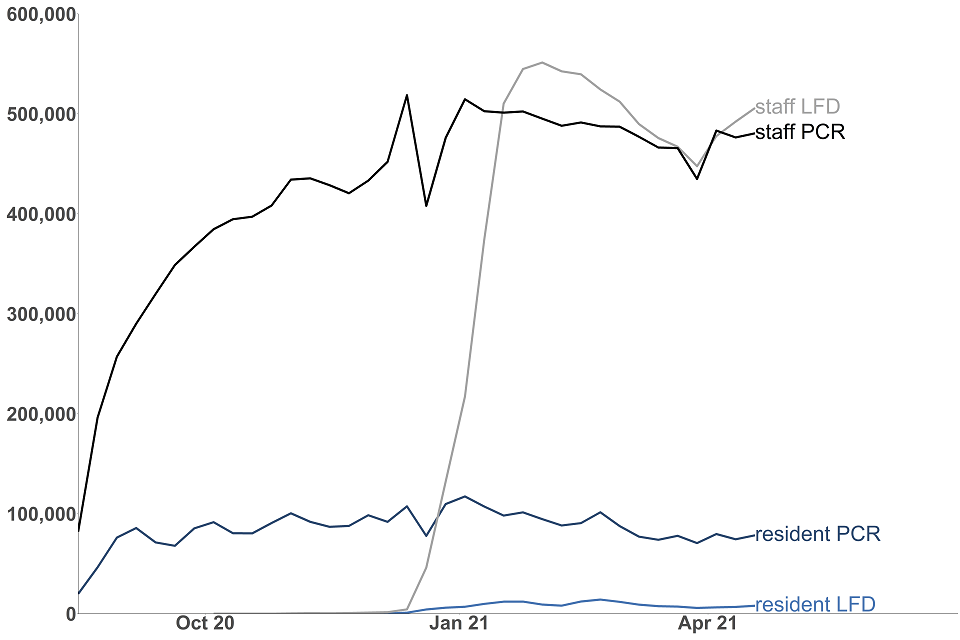
This data can be found in Tables 1 and 2 of the accompanying ‘Testing’ tables in addition to data by region and local authority.
Visitors
Following the change in guidance for residents receiving visitors on 8 March 2021, there was a sharp increase of LFD tests conducted among visitors to residents of care homes, from 12,010 tests in the week ending 2 March 2021 to 44,854 tests in the week ending 16 March 2021. The number of tests conducted among visitors has been gradually increasing throughout April.
Positive test results returned in adult care homes
Care home staff
The number of positive test results returned from PCR kits in care home staff steeply increased from 2,022 tests in the week ending 8 September 2020 to 19,522 in the week ending 12 January 2021. Thereafter the number of positive test results from PCR kits has overall fallen sharply with 319 returned in the week ending 27 April 2021.
There were 3,137 positive test results returned from LFD kits in the week ending 12 January 2021. The number of positive test results has since declined with 411 identified in the week ending 27 April 2021.
This reflects the fall in the rate of prevalence and number of outbreaks of COVID-19 in care homes.
Care home residents
The number of positive test results returned from PCR kits in care home staff steeply increased from 846 tests in the week ending 8 September 2020 to 9,413 in the week ending 12 January 2021. Thereafter the number of positive test results from PCR kits has overall begun to sharply decline with 121 returned in the week ending 27 April 2021.
There were 1,047 positive test results returned from LFD kits in the week ending 12 January 2021 and the number of positive test results has since been gradually declining with 14 identified in the week ending 27 April 2021.
This reflects the fall in the rate of prevalence and number of outbreaks of COVID-19 in care homes.
Figure 8: number of positive test results returned in care homes, England
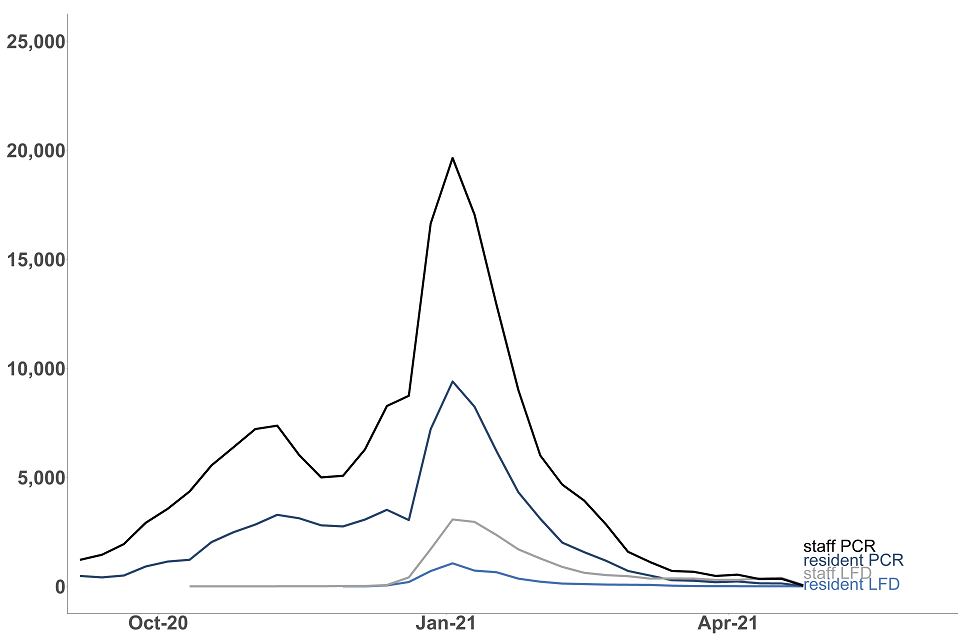
This data can be found in Tables 1 and 2 of the accompanying ‘Testing’ tables in addition to data by region and local authority.
Staff and residents have different testing regimes as outlined in Table 3. As a result, the number of positive test results returned is expected to be of a different scale between staff and residents.
Visitors
There have been very few positive tests returned in visitors to residents of care homes or visiting professionals.
About this data
These statistics are being published as a part of a wider landscape of statistics on adult social care. The Government Statistical Service (GSS) compiles a UK adult social care database of official statistics on adult social care across the 4 nations of the UK. This is updated on a monthly basis.
The UK Statistics Authority (UKSA) conducted a review of adult social care statistics in England which called for:
-
better leadership and collaboration across different organisations publishing official statistics. This publication has been produced in collaboration with other statistics providers of COVID-19 adult social care data and DHSC will endeavour to work with various stakeholders as more data is published through this publication
-
addressing of gaps in available data, particularly in privately funded care. This bulletin aims to plug some of that gap by including data on residents privately funding their care in addition to those funded by local authorities
-
improving existing official statistics. These statistics are being badged as experimental statistics and more data will be added iteratively based on user needs
Other sources of adult social care COVID-19 data
COVID-19 vaccinations
NHS England and Improvement (NHSEI) also publish data on vaccinations in adult social care settings as part of their broader statistical release on COVID-19 vaccination, using the same methodology and the same data source as this publication but there are differences in the:
-
reporting period; data in this publication reports data collected up to 11:59pm on a Tuesday whereas NHSEI use data collected up to 11:59pm on a Sunday
-
a small amount of data may be collected after the respective reporting periods
-
regional breakdowns; data in this publication uses the administrative regions of England and NHSEI use NHS regions
COVID-19 testing
DHSC also publishes care home testing data in the weekly NHS Test and Trace statistics (England) at national level. This publication uses the same data source but has a different methodology for presenting testing in care homes and differences in the figures will occur due to the following reasons:
-
differences in which tests from different routes are included. Both methodologies include the number of tests registered from kits sent directly to care homes, but this publication additionally includes care home staff or residents tested via other routes such as regional or local test sites. As a result, figures in this report will be substantially higher for PCR tests conducted in care home staff due to the current guidance recommending staff with symptoms to be tested outside of the care home (see coronavirus (COVID-19) testing in adult care homes for more information)
-
different reporting periods. This publication uses the start time of the test in comparison to the Test and Trace statistics which use the date on which the test result was received by the individual taking the test
-
different times of extracting the data
For more details on the NHS Test and Trace programme and the statistics please see the NHS Test and Trace methodology document.
Data sources
COVID-19 vaccination, infection prevention control (IPC) and staffing level data
Data in this publication is taken from self-reported data submitted by care providers in England through a data collection and insight tool called Capacity Tracker.
Care providers are expected to submit data on IPC compliance and staffing-levels on a weekly basis whilst data on vaccination is expected to be updated on a daily basis.
For more information, please see the ‘Data Sources’ section of the accompanying methodology note.
COVID-19 testing data
Testing data is collected from management information generated during the operation of the NHS Test and Trace service.
For more information, please see the ‘Data Sources’ section of the accompanying methodology note.
Data coverage and quality
All data in this publication refers to adult social care settings in England only.
Data submitted by providers reflects the current priorities to monitor the COVID-19 pandemic in social care settings. Data collection could be subject to change based on changes to the priorities and therefore the reporting in this publication will be adapted accordingly.
IPC and staffing level data
Providers are expected to submit data on IPC measures on a weekly basis and staffing levels on a daily basis. Any providers who have not submitted data within the last 7 days are excluded from the relevant analysis for the associated time period where no response was received. The full response rates for all data points are available in the accompanying tables.
Vaccine data
Data on total number of staff and residents as well as those vaccinated is self-reported by care providers and local authorities (LAs). Providers are expected to update their vaccination data on a daily basis. There may be a time lag between individuals receiving the vaccine and the week they are reported in the statistics depending on when providers have updated their vaccination data.
Testing data
This report includes the number of tests conducted on care homes residents, staff and visitors who were tested by:
-
PCR and LFD kits sent directly to the care home for regular testing, which were registered through the National Testing Programme digital infrastructure
-
PCR and LFD kits conducted at another testing site such as a regional or local test site or a mobile testing unit or tests that were registered
The figures in this report are only deduplicated to report on the number of individual tests taken, not the number of people tested. Because people can have more than one test, the data should not be compared with prevalence rates or case positivity rates.
This report does not contain data on those tested through pillar 1.
Data for each reporting period relates to the day an individual took their test.
Revisions
Any revisions to past publications will be in line with DHSC’s revision policy and highlighted in future publications accordingly.
Future developments
We plan to add new statistics to this publication to support user needs. Over the coming months, we will explore the feasibility of publishing the following statistics:
-
second dose COVID-19 vaccinations in social care settings for staff and residents
-
personal protective equipment (PPE) levels in care homes
Feedback
For feedback and any further questions, please contact asc.statistics@dhsc.gov.uk.
-
Due to the change in guidance issued on 23 December 2020 to increase testing in care home staff, the requirement for care home staff to register negative LFD test results was suspended between 31 December 2020 and 15 January 2021 inclusive. As a result, a proportion of LFD tests conducted on care home staff will not be included for these dates. ↩
